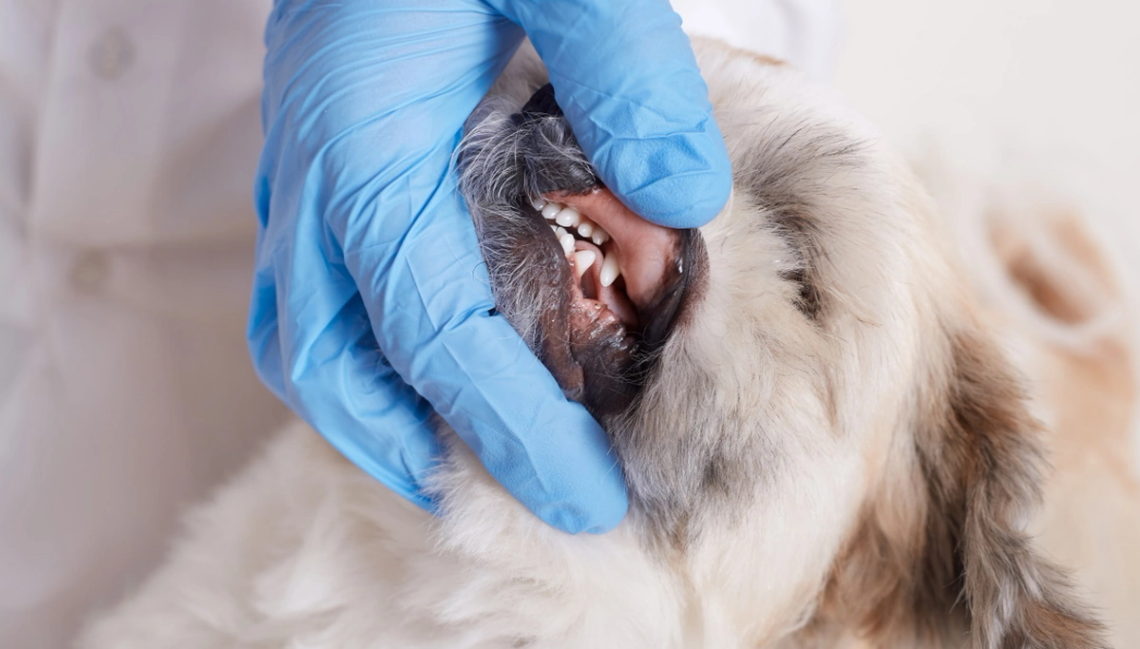(Original Article Published via RawFoodForPets.com)
A silent, fatal but preventable disease!
Pet parents and guardians revel in the presence of their fur kids, those furry critters in their life that ask for so little, yet give so much. As a dedicated pet parent, you want to ensure a healthy, happy life for your mutts, pups and nobles. Sadly, this silent, preventable disease is painful, and often deadly, to numerous pets over the age of three.
A silent, fatal but preventable disease ..
Continued studies by Drs Cheryl London and Katie Janeway, through the concept of comparative oncology, at the Dana-Farber / Boston Children’s Cancer Center in the UK, show that at least 85 percent of canines over the age of three will suffer form a silent, fatal but preventable disease. These current studies, in our minds, now vindicate what Dr Tom Lonsdale (DVM) advocated so many years ago, for which he was expelled from the Australian Veterinary Association!
Foul-Mouth AIDS?
Dr Lonsdale calls this the ‘pandemic of periodontal disease in pets’, and highlighted this condition as a major cat and dog health issue, calling the canine condition “Foul-mouth AIDSâ€. Dr Lonsdale saw the bacterial proliferation in dog’s mouths as suppressing their immune systems, leading to a host of health problems.
Dr Cheryl London is a research professor at the Cummings School of Veterinary Medicine at Tufts University and the study is done in an effort to understand cancer in dogs while developing new treatments which may be applied to humans. Dr Katie Janeway treats bone cancer in children in the same manner as Dr London treats dogs with cancer.
Most pet owners have heard of the periodontal disease and the importance of caring for your fur kid’s teeth and gums, but many do not follow through to protect their pet.
These new age studies confirm that the culprit in oral disease is bacteria that causes gum disease. Immediately after eating, the combination of food, saliva, bacteria and other particles begin to form a sticky substance along the teeth known as plaque. Without treatment, like humans who brush and floss, the bacteria affects the immune system. It also culminates with inflammation, bad breath, extreme pain for the pet, tooth loss and can get into the bloodstream. If that occurs, the condition can lead to critical issues, affecting the kidneys, lungs, and heart. Your fur kids could be suffering in silence.
Comparative oncology, a new field and method of tackling cancer, is where cancer doctors work together to find a cure, with the idea that many cancers in humans and dogs are very similar. Such cancers in dogs like melanoma, lymphoma, and breast cancers are almost indistinguishable from their human counterparts. The program puts new meaning to man’s best friend, especially if they can help save a life. Dr. Janeway states that through the study of Osteosarcoma, the disease in dogs and kids is amazingly similar. The goal is to find a promising drug for the cure. Research continues to help fight bone and other types of cancers in both canine and humans.
Many other medical and veterinary professionals echo these sentiments:
â€Nutrition is serious health business. The public is not well served by exclusively feeding products from companies without any real commitment to health… or knowledge of how to even achieve that. Recent studies have shown processed foods to be a factor in increasing numbers of pets suffering from cancer, arthritis, obesity, dental disease and heart diseaseâ€. Dr. Randy Wysong, DVM
“The benefits of a natural diet go beyond merely preventing disease. After only 3-4 weeks on the new diet, people usually notice a dramatic improvement in the skin and coat, less odour, fewer fleas, brighter eyes, and better energy and behaviour. Not only can you see the signs of improved health, but you will also save money in the long run due to fewer and lower veterinary bills. The healthier your pet is, the less likely s/he will be to have fleas, skin problems, allergies, heart worms, feline leukaemia, dental disease, and many other common disease problems.†Dr Jeffrey Levy DVM PCH
The Conclusion?
Dental cleaning under anaesthesia has become the norm, an expensive one at that, given that the vast majority of dogs suffer from dental disease. One has to postulate that this is because the vast majority of dogs are fed kibble and starch-laden diets. But this only compounds the risk of feeding your fur kids a processed diet.
In an article entitled “Remove Malpractice Risk from Anesthetic Risk” published in DVM360 (see: Remove malpractice risk from anesthetic risk, Christopher Allen, DVM (Article)), June 1st, 2004, veterinarian and attorney Dr Christopher Allen wrote, “Clients who sue are shocked clients; they sue after they bring in a reasonably healthy looking pet but leave with their animal in a plastic bag. They sue when their high-risk pet dies under anaesthesia and no one fully explained the concept of anaesthetic risk. A disproportionate number involve pet deaths that have occurred while an animal was sedated or under anaesthesia.â€
Dr Michael Fox claims, “Obesity and dental problems are associated with highly processed manufactured pet foods, especially those high in cereals“, and adds, “Cleaning teeth on a regular basis under general anaesthesia is a high-risk money-maker that can mean death for otherwise healthy animals.â€
Clearly, Dr Lonsdale’s little experiment should be a wakeup call for pet parents and guardians alike?
Dr Will Falconer comments “Do wolves die toothless? Or live with decayed teeth, tartar encrusted teeth, or yellow teeth? Of course not. How is this possible?â€
According to Dr Falconer, the more importantly the question should be “how did we come to believe all this hype about teeth brushing and dentistry? And what sorts of things have we foisted on the animals that has caused all this dental disease?“
“It can only be that this chronic disease has come from our deviating from the wild model, raising our pets in ways that are quite different from that of their ancestors and wild cousins, the wolf and bobcat.â€
Will Raw Food Diet Help Prevent Tartar Build Up for my Dog?
Dr Sara Chapman concludes, “Raw meaty bone diets keep wild carnivores’ teeth in top condition, and they can do the same for our domesticated carnivores. Even ground raw diets help prevent tartar build up, as the meat contains natural enzymes, and raw diets do not stick to the teeth, unlike diets that are high in starch. Kibble (dry food) has long been touted as helping to keep teeth clean because of its abrasive action. If you have ever watched your dog eat kibble, you have surely noticed that they don’t chew the stuff, they bolt it down whole. I encourage all my clients to feed a balanced, high quality raw diet if possible; balanced high quality cooked or canned diets are acceptable alternatives if they can not feed raw.â€
Despite proper diet, some fur kids are genetically predisposed to dental disease … especially toy breeds and short-nosed breeds.
Dr Karen Becker offers some points to ponder and solutions to keep your fur kids’ mouth healthy and bacteria-free:
- Offer recreational, raw bones. Offering your pet raw knuckle bones to gnaw on can help remove tartar the old fashioned way – by grinding it off through mechanical chewing. There are some rules to offering raw bones (not for pets with pancreatitis, diseases of the mouth, weak or fractured teeth, resource guarders, “gulpers,†etc.) so ask your holistic vet if raw bones would be a good “toothbrush†for your fur kids. Dr Becker recommend offering a raw bone about the same size as your pet’s head to prevent tooth fractures.
- If your dog cannot or should not chew recreational raw bones, Dr Becker recommend you offer a fully digestible, high quality dental dog chew;
- Lastly, Dr Becker recommend that you perform routine mouth inspections. Your pet should allow you to open his mouth, look inside, and feel around for loose teeth or unusual lumps or bumps on the tongue, under the tongue, along the gum line and on the roof of his mouth. After you do this a few times, you’ll become sensitive to any changes that might occur from one inspection to the next. You should also make note of any differences in the smell of your pet’s breath that aren’t diet-related.
Ready to start feeding a raw diet?
Additional Articles and Videos
- How dogs may help fight bone cancer, CBS News (CBS News);
- Colorado State University (CSU) Comparative oncology documentary set for national release (ColoState);
- Dental Problems In Pets by Dr Michael Fox, Dogs Naturally Magazine (DNM) (Dogs Naturally Magazine);
- The Disturbing Cause Of Dental Disease In Dogs by Dana Scott, Dogs Naturally Magazine (DNM) (Dogs Naturally Magazine);
- Many pets not old but stricken with diet-induced AIDS by Dr Lonsdale (RMB);
- Natural Dental Prevention: Common Sense In The Mouth by Dr Will Falconer, DNM (Dogs Naturally Magazine);
- A Natural Approach To Tartar Build Up by Dana Scott, DNM (Dogs Naturally Magazine);
- Remove malpractice risk from anesthetic risk by Dr Christopher Allen, DVM360 (DVM360);
DIY ToothPaste for Pets – recommended by Dr. Karen Becker
* Disclaimer: This information is for educational purposes only and is not intended to replace the advice of your own veterinarian or doctor.





